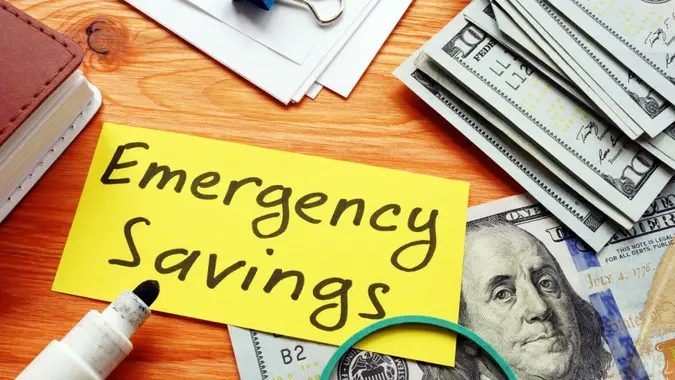How To Make a Savings Plan

Commitment to Our Readers
GOBankingRates' editorial team is committed to bringing you unbiased reviews and information. We use data-driven methodologies to evaluate financial products and services - our reviews and ratings are not influenced by advertisers. You can read more about our editorial guidelines and our products and services review methodology.

20 Years
Helping You Live Richer

Reviewed
by Experts

Trusted by
Millions of Readers
A savings plan is the cornerstone of a successful financial plan, particularly in today’s economy. As the economic environment is currently uncertain — and a recession may be looming — building cash reserves is a good plan. This is true no matter how much money you earn. What’s important is consistency and having a strategy.
Step 1: Set Clear Savings Goals
When it comes to savings goals, vague ambitions won’t cut it. Define your savings goals using the SMART criteria — specific, measurable, achievable, relevant and time-bound.
For example, you might decide you’ll save $10,000 for a down payment on a house in the next 10 months. To do this, you’ll commit to putting $1,000 per month into your savings account.
SMART savings goals are important because they give you something specific to work toward. The structure around this type of objective leaves no room for slacking, so if you don’t follow through, you clearly sold yourself short.
You should also divide your savings goals into short-term and long-term. Short-term goals include an emergency fund and a vacation fund, while intermediate-to-long-term goals include saving for a home down payment, college, or retirement.
Step 2: Know Your Starting Point
Before you can build a savings plan, you need a clear view of your finances–which starts with a budget. Tracking your income and expenses shows how much you can realistically save. Budgeting apps like YNAB and Honeydue can make this easier.
If there’s little left to save, look for ways to cut back or increase your income. Chances are, you’re overspending somewhere–unused subscriptions or frequent takeout add up fast.
Use your budget to guide smarter choices. You don’t have to cut all nonessentials–just prioritize what brings you the most joy. Set limits on discretionary spending to balance your needs, wants, and savings goals.
Step 3: Choose the Right Savings Strategy
There are various strategies you can use to save money. Most successful savers use some combination of all three of the most common methods.
Paying Yourself First
Paying yourself first is an oft-recommended strategy in which you set money aside for savings and investments as soon as you get your paycheck. Then, you learn to live off the amount that remains. If you follow the opposite strategy — waiting to save until the end of the month — you’ll may not have anything left to save. This simple tweak in your strategy can help guarantee that you’ll always save money every single month.
The 50/30/20 Rule
The 50/30/20 Rule is a method for allocating your income to ensure you always set aside a portion for savings. Under this strategy, you’ll use 50% of your income for your “needs,” like food, rent and utilities. Thirty percent will go to your “wants,” such as eating out or streaming services. The remaining 20% goes to your savings.
Automated Savings
You can prioritize savings by setting up automatic transfers from your checking account. This ensures the money will actually make it to your savings account, instead of unwittingly being diverted to another cause.
You can always make adjustments to the transfers as needed. This is just a preventative step to remove any temptation that might come from putting the money in your hands first, before it heads to savings.
Step 4: Pick the Best Account for Your Goals
Putting your savings in the right place(s) is key. For example, your retirement savings should be in a 401(k), IRA or similar retirement savings fund. On the other hand, it might be best to put your general savings in a high-yield savings account, a money market account or a certificate of deposit (CD).
- High-yield savings accounts (HYSAs) are FDIC-insured and offer higher interest rates than traditional savings accounts, but they’re usually offered by online banks–so branch access may be limited.
- Money market accounts are also FDIC-insured and combine features of savings and checking accounts, often with check-writing privileges. They may require higher minimum balances.
- Certificates of deposit (CDs) typically pay more interest than HYSAs or money markets but are less liquid. With fixed terms, early withdrawals usually come with penalties.
- Some specialty accounts, like holiday or kids’ savings accounts, cater to specific goals and may offer added features or incentives.
Each savings tool has its purpose. Using separate accounts for different goals can help you stay organized. When in doubt, talk to a financial advisor.
Step 5: Track Your Progress and Adjust as Needed
Saving money may not feel exciting, especially when you can’t see the progress. But checking your bank statements regularly–monthly or quarterly–lets you track your growing balance and interest earned, which can help keep you motivated.
Life changes like a raise, a big expense, or new bills may call for plan adjustments. For instance, you might boost savings after a raise or rebuild your emergency fund after using it.
Celebrating milestones can also help you stay on track. Just be sure any rewards fit within your budget. Small wins matter–acknowledge them without derailing your progress.
Tips To Stick to Your Savings Plan
If you’ve drafted a realistic, comprehensive savings plan, you should be able to follow it. Here are some tips to help you stay on track:
- Set up automatic transfers
- Use visual trackers or goal-setting apps
- Cut back on low-priority spending
- Remind yourself why you’re saving
If you can keep all of these suggestions in mind, it should make saving more of a priority and less of an obligation.
What a Sample Savings Plan Looks Like
Here’s what a sample savings plan might look like:
- Set a goal: A six-month savings goal might be $2,400
- Create/analyze your budget: Carve out 20% of your income for savings, or at least enough to save $400/month to meet your goal. If you’re struggling to find out where you can save, look at your budget to see where you are overspending.
- Automate your savings: Set up monthly transfers from your bank account that move your money as soon as you get paid, before you’re able to spend it on discretionary items.
- Monitor your progress: After three months, you should be 50% of the way to your goal. In this scenario, you should have $1,200 saved. If you’re coming up short, see if you’ve followed the first steps correctly. Make adjustments where necessary.
This sample six-month plan is one that you can modify for your lifelong savings. Just remember that as your income and expenses change over time, you should update your goals and the amount you save.
FAQ
Here are the answers to some of the most frequently asked questions about savings plans.- What is a good savings plan?
- A good savings plan helps you regularly put money aside for the future. It matches your financial goals, is realistic about how much you can save and includes a clear idea of what you're saving for.
- What is meant by a savings plan?
- A savings plan is your strategy for saving money over time. It involves deciding how much of your income you'll save for things like emergencies, big purchases or retirement.
- How do I create a savings plan?
- To create a savings plan:
- Figure out your current finances and expenses.
- Decide what you're saving for.
- Set a monthly savings amount.
- Pick where to keep your savings, like in a bank account.
- Make saving automatic with regular transfers from your checking to your savings account.
- Check in on your progress now and then.
- To create a savings plan:
- How do I get a savings plan?
- Getting a savings plan means making one based on your financial situation and goals. Look at your money coming in and going out, set some savings goals, choose the best place to keep your savings and start putting money away regularly. If you're not sure where to start, talking to a financial advisor can help.
Our in-house research team and on-site financial experts work together to create content that’s accurate, impartial, and up to date. We fact-check every single statistic, quote and fact using trusted primary resources to make sure the information we provide is correct. You can learn more about GOBankingRates’ processes and standards in our editorial policy.
- SoFi. 2023. "Using the 30 Day Rule to Control Spending."
 Written by
Written by  Edited by
Edited by 

























